A 4K capable graphics card.
For an index of all my Mac Pro articles, click here.
I first wrote of the Zotac nVidia GTX660 graphics card used in my Mac Pro back in my Hackintosh days. That Zotac card has proved to be outstanding, cool running, silent and capable of simultaneously running four displays (2 x DVI, 1 x DP, 1 x HDMI). When I migrated to the 2009 Mac Pro the Zotac joined that migration and except for the lack of the cog wheel/splash screen on a cold start of the Mac, the card was compatible in every way.
My displays are rather dated Dell 2209WA IPS panels, 21″ in size, and I use three. Eventually these will give way to two larger 4K panels once the technology settles down but with a far higher pixel density (3840 x 2160 vs. 1680 x 1050 computes to 4.7 times the number of pixels for a like sized screen) I will go from 21″ to 30″ or so, and the factor increases to 9.6 times. That’s a big increase.
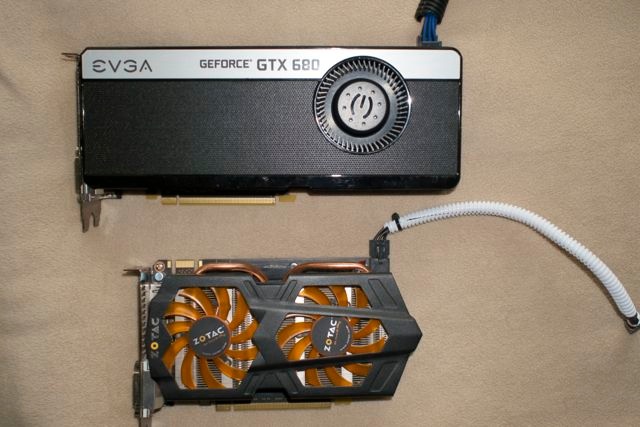
The EVGA has only one fan, yet the card is much larger overall.
Thus I decided to get the best ‘Made for Mac’ card out there, the choices being the ATI Radeon 7950 or the EVGA nVidia GTX680 both ‘Made for Mac’ variants selling for some $600 new. I like the external connector choices on the EVGA more and found a used, mint GTX680 on eBay for $450. I doubt you will go wrong with either. There are yet faster cards but not in ‘Made for Mac’ editions and power consumption becomes an issue, many of these really requiring auxiliary power supplies if they are to be driven hard and if damage to your computer is to be avoided.
The power consumption issue:
The EVGA GTX 680 requires the use of two auxiliary 6-pin power cables connected to the backplane board, in addition to the power provided by the double-width PCIe slot. Each of these runs at 12 volts and can deliver up to 75 watts of power (6.25 amps of current – more than that and you risk frying things).
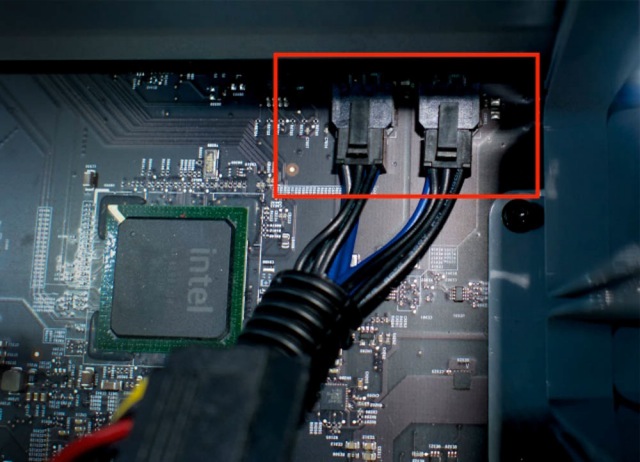
The two 6-pin connectors attached to the backplane board. I use 1/2″
flex tubing to neatly dress the cables. The PCIe fan is on the right.
The EVGA card I bought came with two six pin cables while the card itself has one six-pin and one eight-pin socket. The instructions clearly state that the 8-pin will accept a six-pin in one orientation only and this proved to be true.
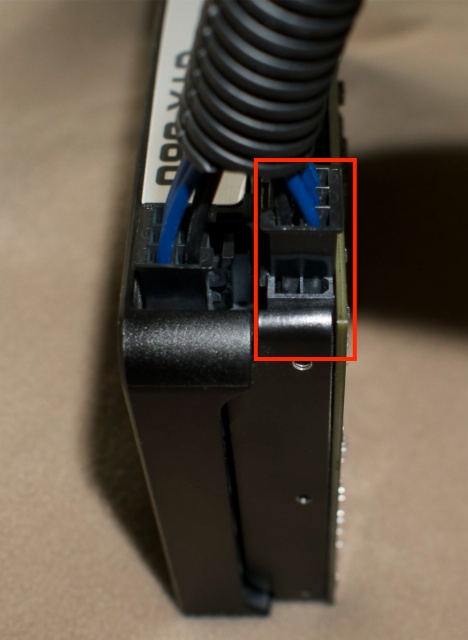
One of the 6-pin connectors goes in an 8-pin socket at the card end.
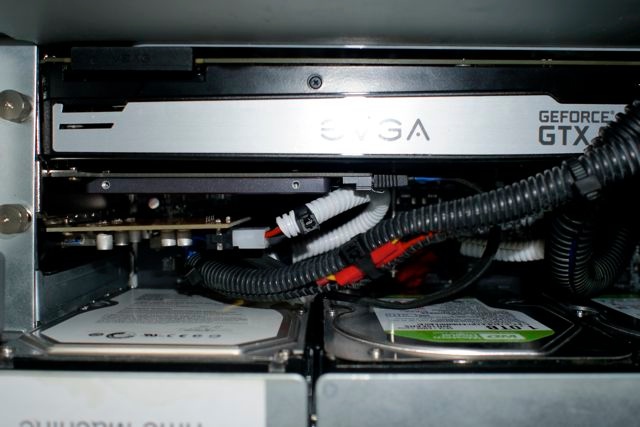
GTX680 installed. The Apricorn PCIe card with the boot
SSD is below and the powered Orico USB3 card below that.
Installation in the double-width Slot 1 is a breeze, and no tools are required. It took me some 10 minutes, most of that spent unplugging and replugging cables to the Mac Pro. As with the GTX660, the claw at the rear base of the GTX680 is retained by the sliding bar activated by the push button on the PCIe fan’s casing, the latter being moved back for removal and installation, then pushed back into place, making for a secure fit for this large and heavy card.
Why Slot 1? Because inserted in any other slot your card will block a free slot. Not good, considering there are only four PCIe slots available in any Mac Pro.
Static current draw in PCIe slot 1 is 2.95 amps (35 watts) compared with 2.46 amps (30 watts) with the GTX660. An immaterial increase and the new card seems every bit as silent as the old one which was outstanding in this regard.
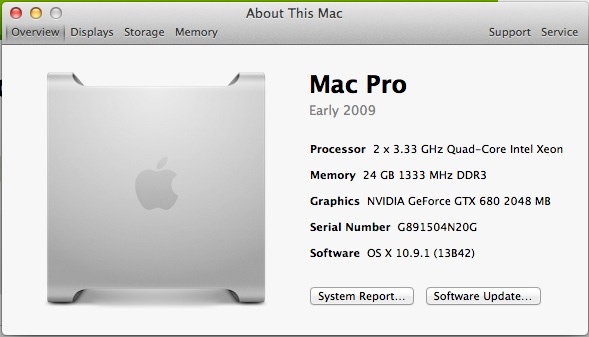
About This Mac.
The full splash screen appears on cold start, allowing choice of boot drive if the Option key is held down during start. This was a black screen in the GTX660 so boot drive selection had to be made in System Preferences->Startup Drive before restarting. It’s nice to have the splash screen back, but hardly a reason to upgrade, especially as I never turn off the Mac Pro, preferrring to let it sleep. Adventurous hackers can buy a stock PC GTX680 and, using Windows, flash its ROM for the splash screen functionality. As I do not use Windows, and as there is no circumstance under which I can see that changing, I opted for the ‘Made for Mac’ flashed card – though the appearance of the casing on mine suggests it’s actually a flashed PC version. There’s no difference in use. It’s not the first, nor the last, time that a vendor on eBay has lied. For new cards there is negligible price difference between Mac and PC versions and the Mac version will work fine on PCs.
The PCIe fan spools up to some 1500rpm on cold start then quickly settles to the stock 800rpm idle in under 30 seconds:

Noise at ear level (3′ from the front grille) measures at 43dB, the same as with the GTX660, whether idling or under stress.
Benchmark tests:
The most stressful tests for graphics cards include Unigine Heaven (now in 4.0 guise) and the recently released Unigine Valley (v. 1.0), and I show comparisons with the GTX660 below. All run using OS X Mavericks 10.9.1. The GTX680 is 73% faster on Heaven and 10% faster on Valley:
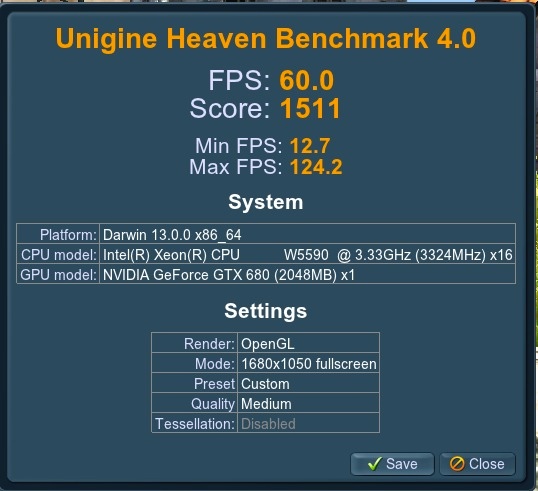
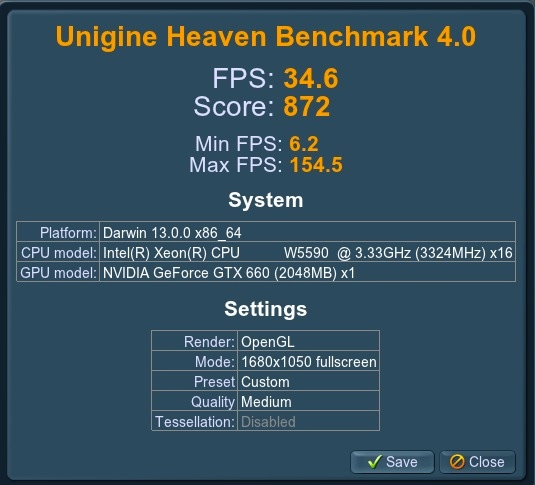
Heaven – GTX680 vs. GTX660
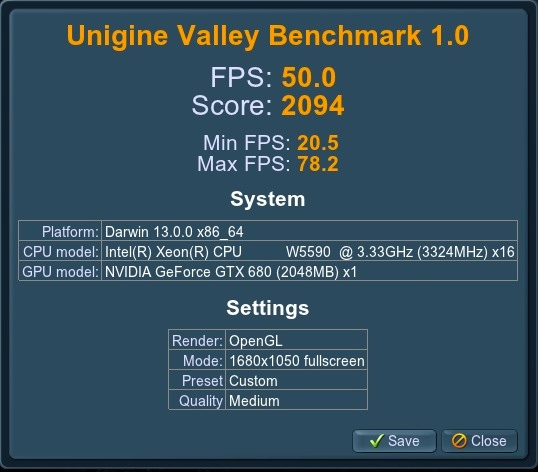
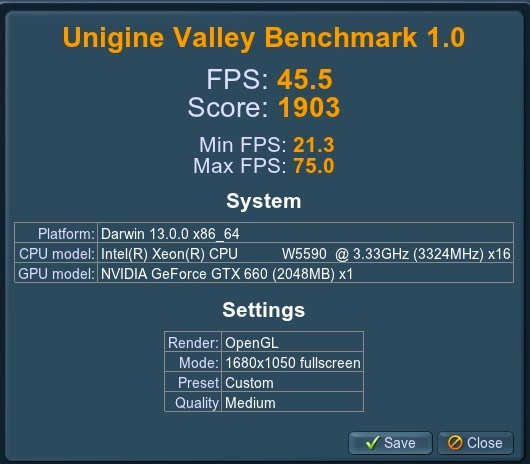
Valley – GTX680 vs. GTX660
With two X5650 12-core CPUs performance is much the same as with two X5590 8-cores:
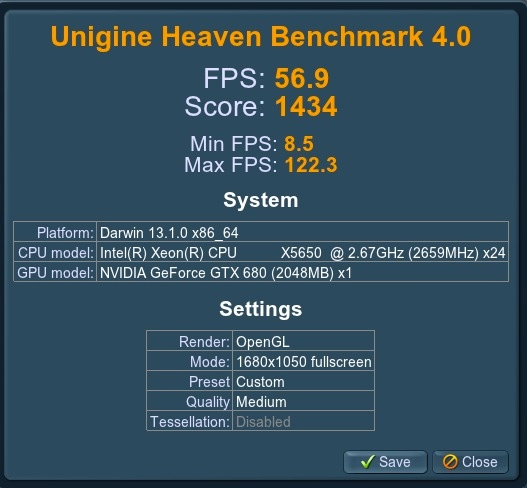
Heaven – 12-core performance.
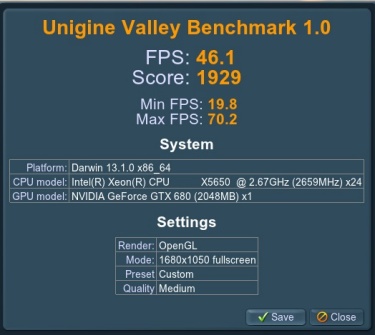
Valley – 12-core performance.
This is as expected. These are GPU tests, not CPU tests.
How about power consumption under stress? Using Unigine Heaven as the most stressful test, the current draw from the three sources (PCIe plus the two 6-pin connections) measured thus (worst cases shown):
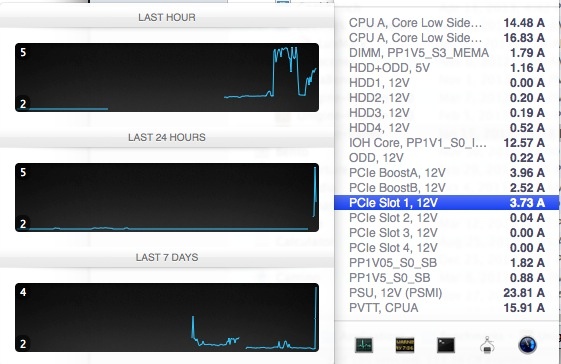
PCIe current draw.
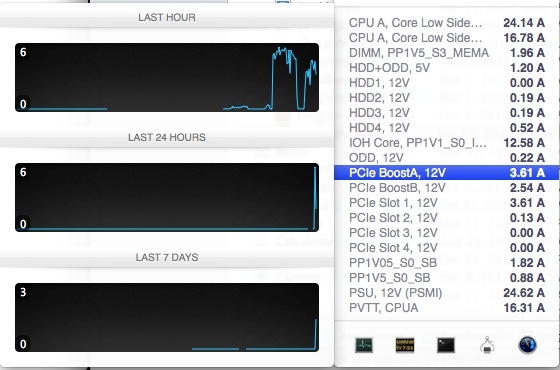
First six pin connector current draw.
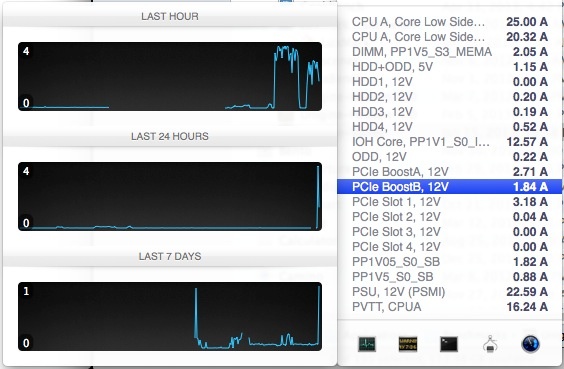
Second six pin connector current draw.
That total power use of 52/63/42 watts, respectively, meaning 157 of a total permitted of 225 watts – is 70% of overall capacity. But individual percentage of capacity is equally important here – you can be under in aggregate but over on one source, a danger point. With each limited to 75 watts, the highest use noted was the 63 watts on 6-pin slot 1, or 84% of capacity. Given the very stressful nature of this test and the short-term peak power use, I remain satisfied that the health of my Mac Pro is not threatened.
With Unigine Valley, the maxima noted were 51/37/41 watts, for a more modest total of 129 watts, and a worst case use of 68% at the PCIe slot.
Monitoring the 1,000 watt Mac Pro power supply, I never saw power use exceed 500 watts during the Unigine Heaven test, a mere 50% of capacity.
GPU temperatures:
I cannot report on these as the GPU sensor is not ‘seen’ by the system. However, the power draw readings, above, are a fine proxy for determining GPU stress, and the permitted maximum power draw is not exceeded here.
Real world subjective use with Lightroom 5.1 and Photoshop CS5:
I’m not one much for subjective data. “It feels faster” is usually the placebo effect at work. But here are my subjective observations with LR and PS, applications I use all the time.
Lightroom is a key app for me and I actually noted a perceptible improvement. The occasional “Loading …†flag when flipping fast through 1:1 previews (I would get it 30% of the time) and the associated 2 second delay has now fallen to 2-3% of the time and a consistent 1/2 second delay.
When exporting a file from LR to PS, the longest part of the process is rendering of the PSD file from the RAW original in LR, before it can be opened in PS. With the GTX660 this took 6 seconds. With the GTX680 it’s down to 2.5 seconds – much faster and a noticeable enhancement to workflow smoothness and speed.
Are these improvements enough reason to upgrade? That’s a function of your patience threshold and the state of your pocket book. You will not go wrong with the slower GTX660 but once you have used the GTX680 it’s tough to go back. If your budget is $200, the GTX660 is unreservedly recommended. A new GTX680 is three times as much.
Comparison with the new Mac Pro:
Will the GTX680 match the D300/500/700 dual GPUs in the new Mac Pro? Once test data are available we will know and I will update the metrics above. If it lags, I would guess it will not be by much. Either way, you will have a great deal of money left in your pocket by sticking with the 2009 Mac Pro.
Now it’s time to start thinking about 4K displays. For a full list of nVidia GPUs which support 4K, click here.
Update May 27, 2014 – new OS X drivers: nVidia has just released a new driver which claims to fix all existing 4K issues. Click here.
Update June 6, 2014 – new Mac Pro:
Here’s Unigine Heaven running on the new Mac Pro (cylinder) with the 6-core CPU and dual top-of-the-line D700 GPUs. In a word – underwhelming, epecially given the very high cost of the D700s:
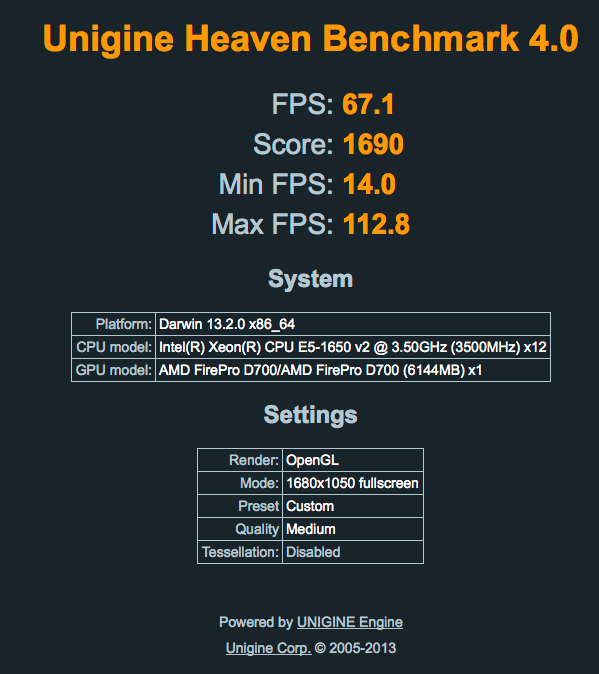
The premium for the D700 GPUs over the base D300 ones is $1,000, whereas a GTX680 ‘Made for Mac GPU’ for the old Mac Pro can be had new for $640, used for half that amount.
Update June, 2015:
The newest top-of-the-like Nvidia GTX980 card doubles the speed of the excellent GTX680 but also doubles the price – $600 new compared with $300 used for a flashed GTX680. Add a further $180 if you need the ROM in the GTX980 flashed to show the boot and option-start screens.
You can get it in many socket configurations from the usual vendors – Nvidia, EVGA, PNY, Gigabyte, Zotac, MSI, etc. – so choose based on your peripherals. I opted for a dual-DVI/DP/HDMI configuration, but if DP or MDP is your thing any number of multi-socket options is available.
For still photographers the GTX980 is overkill but for heavy video rendering using CUDA-capable apps it’s a must and the premium will be quickly recovered from enhanced productivity. You can read all about the GTX980 here and I recommend it without reservation. Performance is some 20% better than the costliest dual D700 option for the new (‘dustbin’) Mac Pro.
Meanwhile, a used, flashed GTX680 at $300 or less is an excellent choice for many users.